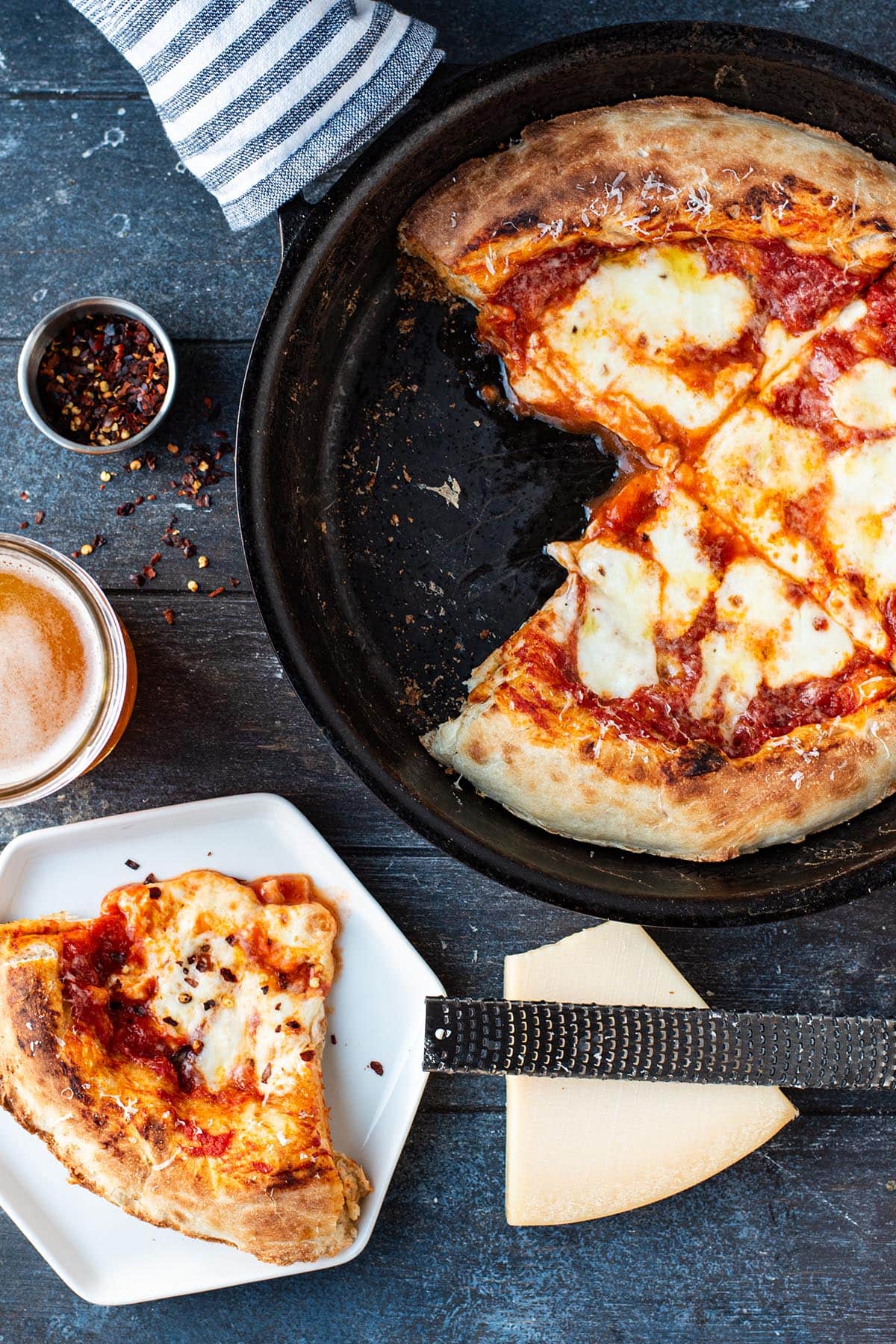This post may contain affiliate links. Please read our disclosure policy.
A cast iron skillet delivers some delicious results when it comes to making homemade pizza in a pan. Similar to a baking steel, the advantage of making pizza in a cast iron skillet is the ability to cook on a very hot surface with greater heat transfer, resulting in better crust and better pizza.

Commercial pizza is nearly impossible to replicate at home because a conventional oven simply can not achieve the same results as a 1000°F brick oven. The skillet method will help you to get more out of your oven.
If you’re looking for more pizza recipes and techniques, check out my Neopolitan-style pizza, grilled pizza, and easy flatbread pizza recipes.
Table of Contents
Why This Recipe Works
- More heat: a hot skillet cooks the crust very quickly, giving you a crispier thinner crust with an airy fluffy texture on the inside. Broiling helps with charring and delivers hotter temperatures.
- Simple toppings: keeping the toppings light, fresh, and authentic will help your pizza cook better and taste better.
Ingredient Notes

- Pizza dough: make your own or use store-bought. Regardless, make sure chilled dough has had 3-4 hours to warm/proof on the counter before baking.
- Mozzarella: you can use low-moisture mozzarella or fresh mozzarella. I like to cube or slice into thin strips.
- Freshly grated parmigiano-reggiano: this is optional but adds a pop of salty flavor.
- Extra virgin olive oil: I lightly drizzle my pizza with nice olive oil just before serving. It adds awesome flavor.
- Canned San Marzano tomatoes: for the best tomatoes, look for imported San Marzano Peeled Tomatoes. These are grown in the Sarnese-Nocerino district and are renowned for their quality due to the mineral-rich volcanic soil near Mount Vesuvius. Pastene and Cento are two brands I’ve used. Also, check out Marcella Hazan’s tomato sauce.
See the recipe card for full information on ingredients and quantities below.
Step by Step Instructions
Step 1.
Remove the dough from the fridge before cooking. Place dough in a greased bowl and seal with plastic wrap or aluminum foil. Let rest for at least 3-4 hours or until the dough is no longer cool to the touch. This is very important for light and fluffy crust. The dough will puff up and nearly double in size when it’s ready.


Step 2.
For the homemade sauce: combine tomatoes, oil, and salt in a small bowl. Blend with an immersion blender until smooth. You can also pulse a blender or food processor. Add more salt to taste as needed. This will render more sauce than you need. I use 1/3-1/2 cup of sauce for each pizza. For a more rustic sauce, you can hand-crush the tomatoes or use a potato masher. If the sauce is too acidic, add a TINY pinch of sugar.


Step 3.
Preheat the oven to 500-550°F with the skillet in the oven. This will preheat the skillet so it’s very hot. For best results, keep the skillet in the oven for an extra 10-15 minutes after the oven has reached the set temp.
Step 4.
Hand-shape the dough into a 10-inch crust. Keep the crust thin with a little extra around the edges. Remove the skillet from the oven and arrange the dough with the crust edges just coming up the sides of the skillet.

Step 5.
Add sauce and then the cheese. Bake for 5-6 minutes 8-10 inches from the heat source on the top rack in the oven. The crust should just be starting to brown.


Step 6.
Turn on the broiler on high and broil for 2-3 minutes until the crust is fully cooked and starting to char. Be sure to watch very carefully as pizza can burn very quickly.
Step 7.
Remove from the oven and immediately top with freshly grated parmigiano-reggiano. Drizzle with olive oil and top with fresh basil. Remove the pizza from the skillet by tilting the skillet and pulling out the crust. It should release from the skillet very easily.

Expert Tips
- Cook on the top rack. Keep the top of the skillet about 8 inches from the heat source in your oven. This will ensure your cheese gets that perfectly golden finish.
- Let your pizza dough come to room temp. Leave the dough on the counter for at least 1 hour before rolling it out and baking. This will ensure quicker cooking and also make the dough less elastic and tough to handle.
- Heat your oven to the highest temp. This is usually 500°F, but some go up to 550°F.
- Place your skillet in the oven as your oven preheats. I can’t stress enough the importance of high temperatures and the speed of cooking when making homemade pizza. Starting with a hot surface will greatly speed up cooking times. If you can, keep the skillet in the oven for 10-15 minutes after your oven has reached 500+°F.
- Keep the pizza crust thin, with a little extra around the edges. Don’t use too much dough or your pizza crust will start to feel bready.
- Finish the pizza with a broil. Broil the pizza for 2-3 minutes at the very end to char the crust. Be sure to watch very carefully as pizza can burn very quickly.
More Pizza Recipes
Enjoy this recipe? If you made this recipe, please leave a ★ ★ ★ ★ ★ star rating in the recipe card below & a review in the comments!
Skillet Pan Pizza

Ingredients
- 10-16 ounces pizza dough, room temp/proofed
- 1/2 cup pizza sauce
- 2 ounces fresh mozzarella, thinly sliced
- 1/4 cup freshly grated parmigiano reggiano
- Fresh basil
- Olive oil
Homemade pizza sauce (makes 1 cup)
- 3 canned San Marzano tomatoes + 2 tablespoons of sauce from the can, look for certified Cento San Marzano Peeled Tomatoes
- 2 teaspoons olive oil
- pinch of salt, to taste
- 1 garlic clove, optional
Instructions
- Remove the dough from the fridge prior to cooking. Place dough in a greased bowl and seal with plastic wrap or aluminum foil. Let rest for at least 3-4 hours or until the dough is no longer cool to the touch. This is very important for light and fluffy crust. The dough will puff up and nearly double in size.
- For the homemade sauce: Combine tomatoes, oil, and salt in a small bowl. Blend with an immersion blender until smooth. You can also pulse a blender or food processor. Add more salt to taste as needed. This will render more sauce than you need. I use 1/3-1/2 cup of sauce for each pizza. For a more rustic sauce, you can hand-crush the tomatoes or use a potato masher. If the sauce is too acidic, add a TINY pinch of sugar.
- Preheat the oven to 500-550°F with the skillet in the oven. This will preheat the skillet so it’s very hot. For best results, keep the skillet in the oven for an extra 10-15 minutes after the oven has reached the set temp.
- Hand-shape the dough into a 10-inch crust. Keep the crust thin with a little extra around the edges. Remove the skillet from the oven and arrange the dough with the crust edges just coming up the sides of the skillet.
- Add sauce and then the cheese. Bake for 5-6 minutes 8-10 inches from the heat source on the top rack in the oven. The crust should just be starting to brown.
- Turn on the broiler on high and broil for 2-3 minutes until the crust is fully cooked and starting to char. Be sure to watch very carefully as pizza can burn very quickly.
- Remove from the oven and immediately top with freshly grated parmigiano-reggiano. Drizzle with olive oil and top with fresh basil. Remove the pizza from the skillet by tilting the skillet and pulling out the crust. It should release very easily.
Notes
Nutrition
Nutrition information is automatically calculated, so should only be used as an approximation.



















love this recipe and love using cast iron! I do have the new pizza pan made by Lodge though, it is much easier for me to use than a skillet!